Economy
Analysis: The Fallacy Of 'Marathi Manoos' Getting Poorer At The Cost Of Gujarat
Krishna Dange
Jun 29, 2024, 01:04 PM | Updated Jul 01, 2024, 12:37 PM IST
Save & read from anywhere!
Bookmark stories for easy access on any device or the Swarajya app.
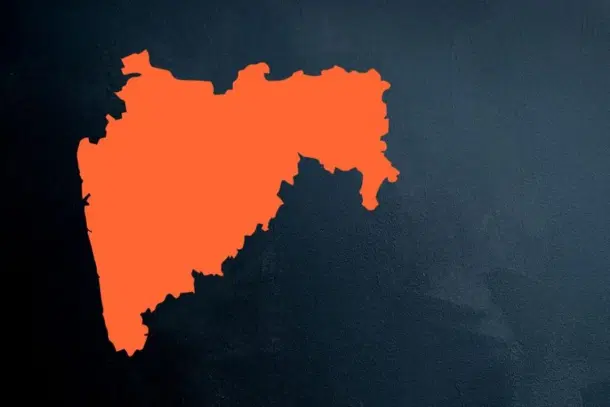
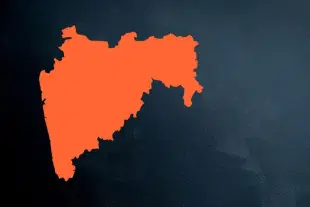
The Mahayuti-led Maharashtra government released the state's economic survey for the financial year 2023-24 (FY24) on Thursday (27 June). The comprehensive document was presented by Finance Minister Ajit Pawar during the ongoing assembly session, ahead of the state assembly elections anticipated in October 2024.
According to the survey, Maharashtra's economy as per the second advance estimate grew at a rate of 7.6 per cent in FY24, in tandem with India’s initial growth rate estimate of 7.6 per cent in the same fiscal.
However, considering that the second revised estimate for India’s growth rate in FY24 came in at 8.2 per cent, Maharashtra's growth rate seems to have slipped below that of the country.
While the survey provides the first revised estimates for Gross State Domestic Product (GSDP) and Per Capita Income (PCI) in FY23, it provides only advanced estimates for other financial heads for FY24.
The real GSDP for FY23 was seen at Rs 2,241,196 crore, up from Rs 2,047,891 crore in FY22.
The nominal GSDP for FY23 was seen at Rs 3,645,884 crore, up from Rs 3,144,138 crore in FY22.
The survey noted that the average share of Maharashtra in all-India nominal GDP for FY23, at 13.9 per cent, was the highest among all states.
The Per Capita Income (PCI) in the state for FY23 was seen at Rs 252,389 lakh, against Rs 219,573 lakh noted in FY22.
As for fiscal deficit, the gap between the state’s earnings and expenditure was seen to have widened sharply, from Rs 67,602 crore in FY23 to the revised estimate of Rs 111,956 crore in FY24.
In contrast, the growth in the state’s revenue receipts has not seen any major rise. In FY23, the revenue receipts were seen at Rs 405,678 crore while the estimate for FY24 is Rs 486,116 crore.
As perused from the survey, over a period of five years, the overall debt obligations of the state have increased by 36.57 per cent from Rs 451,117 lakh crore in FY20 to Rs 711,278 crore in FY24. The Debt Stock for FY23 was seen at Rs 629,235 crore.
Justifying the consistent rise in borrowings, the finance minister said that the debt obligations on the state did not pose any financial risk to the exchequer, as the Debt-to-GSDP ratio for FY24 was seen at 17.6 per cent.
"This is well below the upper cap of 25 per cent imposed by the Union government’s Fiscal Responsibility and Budget Management (FRBM) Committee and the state's own FRBM Act of 2005," Finance Minister Pawar said.
In the case of Foreign Direct Investment (FDI), after losing the top spot to Gujarat in FY21, Maharashtra has regained and maintained the first position since FY22.
In FY24, the overall FDI in Maharashtra is estimated at Rs 100,112 crore. The state’s share in India’s aggregate exports, however, came in second at 16 per cent against 33 per cent of Gujarat.
Can Gujarat Be Blamed For The Drop In Maharashtra's PCI?
Hours after the release of the economic survey, Nationalist Congress Party (Sharadchandra Pawar) Legislator and the state's Former Finance Minister Jayant Patil criticised the ruling coalition government for allegedly letting the state slip from fifth to sixth place in terms of the PCI between FY22 and FY23.
“This slip in terms of the PCI proves that Maharashtra had to suffer the consequences of the projects which were ‘sent’ from our state to other states, especially Gujarat,” Patil said, taking a jibe at the Bharatiya Janata Party (BJP), which is part of the ruling coalition in Maharashtra and is also in power in Gujarat as well as at the Centre.
In an X post, Patil shared a snippet of the PCI numbers from the survey.

Maharashtra BJP leader and Deputy Chief Minister Devendra Fadnavis was quick to counter Patil’s claim. He suggested Maharashtra’s rank in terms of PCI among the Indian states was intact and advised Patil to get his facts right.
“If others spread a false narrative, it is understandable. But if the state’s former finance minister is doing the same, then what should I say?
Remember the era of Maha Vikas Aghadi (MVA)...
2020-21 : 1,82,454 per capita income (Maharashtra 6th);
2021-22 : 2,19,573 per capita income (Maharashtra 6th);
And now 2022-23 : 2,52,389 per capita income (Maharashtra 6th)
...hope that Maharashtra should not be defamed at least by someone like you!" Fadnavis said, perhaps by comparing Maharashtra's PCI with that of Gujarat in FY22, as per which it can be assumed that Maharashtra was on the 6th position even then.
For reasons unknown, the previous year's economic survey does not include Gujarat's PCI in FY22 while comparing it with that of Maharashtra and other states.
However, a closer look at the historical state-wise rankings in terms of the PCI reveals that both leaders have got their facts wrong.
Surprisingly, prominent English as well Marathi news publications too have sung the opposition leader's tune in their reports, without actually verifying whether there was any slip in the ranking.
In fact, the state's economic survey, while comparing Maharashtra's PCI with other states, does not provide state-wise rankings. It simply compares the state's PCI figure with that of a select few states.
This is evident not only from the present edition of the survey but also from the previous edition for FY23, which provides the estimated PCI in Maharashtra for FY22, along with that of a select few states, as seen below.

To precisely ascertain Maharashtra's position in terms of the PCI in FY21 and FY22, it is essential to look at the state-wise data on 'Per Capita Net State Domestic Product (NSDP) at Current Prices' provided in the Reserve Bank of India's (RBI) Handbook of Statistics on the Indian States, 2022-23 (published in November, 2023).
While some states publish the PCI and the per capita NSDP estimates separately, NITI Aayog has specifically considered the latter provided in the RBI publication in order to chart out growth trajectories of each state and union territory's PCI over the years.
In order to gauge the state-wise PCI estimates for FY23, the author has referred to the latest economic surveys published by the state government's of Maharashtra, Gujarat, Kerala, Delhi and Uttarakhand.
As per the RBI publication, when compared with the per capita NSDP of other Indian states and union territories, Maharashtra ranked 14th in FY21 and 13th in FY22. On the other hand, Gujarat ranked above Maharashtra on the 10th position in both financial years.
In case of FY23, while it is difficult to ascertain ranking of both states as reliable numbers for some of the corresponding states are not available in the public domain yet, Gujarat continued to record a higher per capita NSDP inter alia the PCI, than that of Maharashtra.
In fact, despite having the highest GSDP among all Indian states, Maharashtra was outranked thrice even by the southern state of Kerala which is largely dependent on revenue from tourism, agro-processing industries and remittances sent by expatriates.
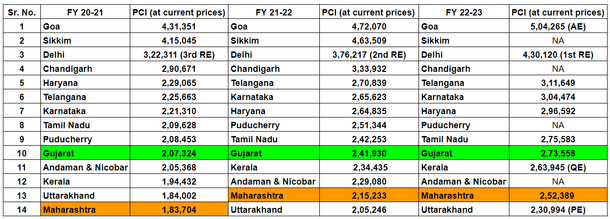
As far as the Maharashtra versus Gujarat dichotomy is concerned, according to the interactive chart of the NITI Aayog which relies on the RBI publication mentioned earlier, Maharashtra's PCI at current prices continued to outpace Gujarat until FY18.
In FY18, Gujarat for the first time recorded a PCI of Rs 176,961, higher than Rs 172,663 noted by Maharashtra. Since then, Gujarat's PCI has continued to outrank Maharashtra.
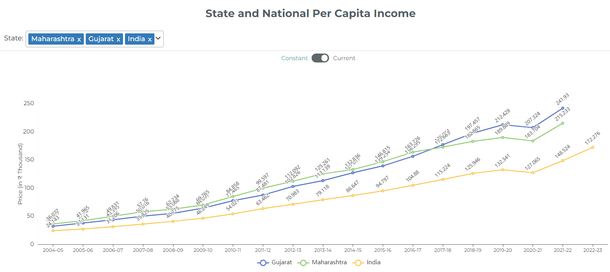
Apart from the rhetoric that allegedly pro-Gujarat BJP leaders, part of the government in Maharashtra, Gujarat as well as the in the centre, were deliberately shifting businesses from Maharashtra to Gujarat, regional parties like Shiv Sena (Uddhav Balasaheb Thackeray) claim that the former is also getting a raw deal in terms of the revenue share devolved to it.
They argue that despite contributing the largest share state-wise to the Central Goods And Services Tax (CGST), Maharashtra receives a relatively smaller share back, hindering development in the state and causing Maharashtra to fall behind Gujarat.
However, a look at the figures provided in the latest economic survey of Maharashtra shows that after devolving a larger share from the central tax revenue pool to Uttar Pradesh and Bihar as per the criteria mandated by the 15th Finance Commission, Maharashtra in FY22 and FY23 among other states received the third and the fourth largest pie consecutively from the same.
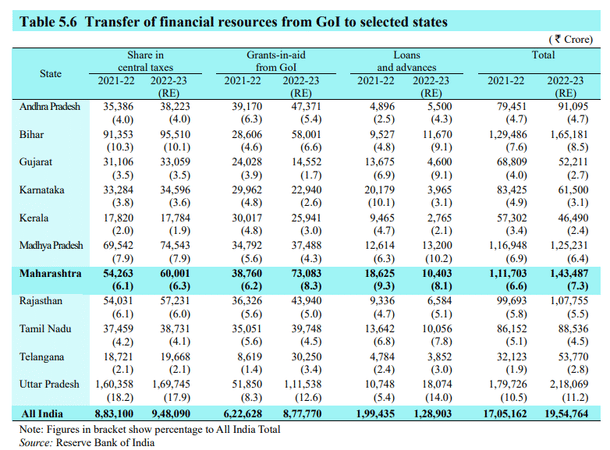
Again, to compensate for Maharashtra losing the largest chunk of the tax revenue, the Union government provided the second largest share of grant-in-aid to the state in FY23. This proves that paucity of monetary resources to carry out developmental works and alternately enhance people's lives is not the problem in case of Maharashtra.
Then, what explains the decline in the state's PCI as compared to Gujarat?
The answer lies in Maharashtra's dismal performance in agriculture and allied economic activities, upon which more than 50 per cent of the state's population is dependent for their livelihood (See page 99 of the economic survey for FY24).
Consider the following figures:
* In FY23, the 'Gross Cropped Area' in Maharashtra as per the recent survey was 244.15 lakh hectare.
* In the same financial year, the 'Total Area Covered Under Irrigation' by the state's Water Resources Department was seen at 42.33 lakh hectare.
This means that a whopping 201.82 lakh hectare, or nearly 82 per cent of the Gross Cropped Area, did not benefit from any kind of irrigation facilities provided by the state government.
If such large tracts of land are cultivated on the mercy of rainfall and numerous unregulated borewells with limited irrigation potential, how is the agriculture sector supposed to perform well and, as a result, enhance the PCI?
To hide this aspect from plain sight, the Directorate of Economics and Statistics of the state government, entrusted with preparing the survey, has mentioned the numbers for irrigation under a standalone table titled 'Total Area Under Irrigation'.
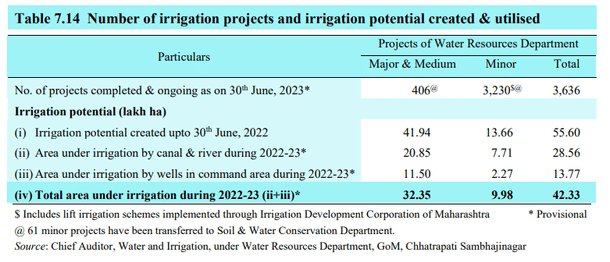
At the same time, in Annexure 7.5, which provides yearly figures for area covered under various forms of irrigation in the state, entries under the heads titled 'Net Area Irrigated', 'Gross Area Irrigated', and 'Percentage Of Gross Irrigated Area To Gross Cropped Area' have been left blank from FY11 onwards.
It is evident that this has been done to hide the state's failure in expanding the area covered through irrigation facilities despite thousands of crores having been spent by the state government on several irrigation projects.
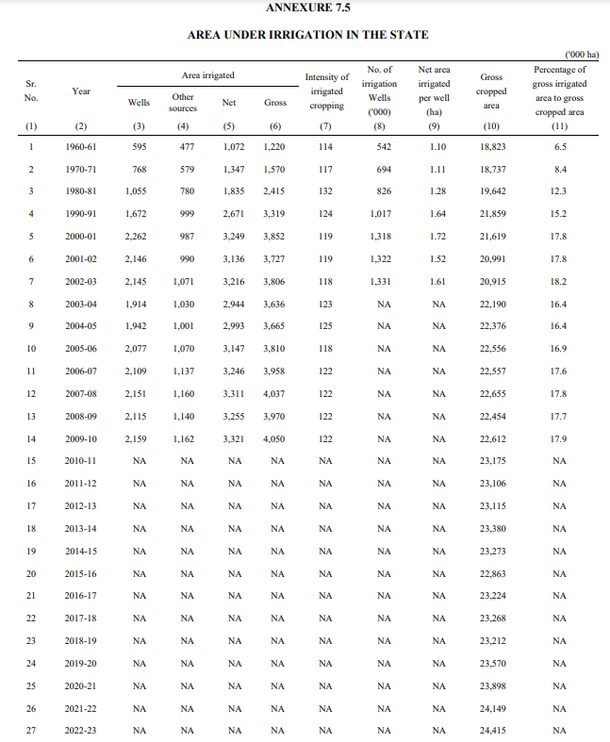
Notably, FY11- from where the entries have been left blank, was the year when reports on the alleged Maharashtra irrigation scam worth Rs 70,000 crore were being published, compelling the then irrigation minister and present Deputy Chief Minister Ajit Pawar to relinquish the irrigation portfolio.
Irrespective of this hide and seek, it is a no-brainer that a large chunk of this 82 per cent of non-irrigated land is in the Marathwada and Vidarbha region, which continues to witness the highest number of farmer suicides, not just in the state but the entire country.
Contrast this with the scenario in neighbouring Gujarat: As per the Season And Crop Report of the state's Directorate For Agriculture, the 'Gross Cropped Area' in the state in FY23 was 147.54 lakh hectare.
In the same fiscal, the 'Gross Area Under Irrigation' was 103.57 lakh hectare; that is, nearly 70 per cent of the area was noted to have been covered under irrigation.
In 2009-10, the last time when Maharashtra published estimates for the percentage of land irrigated, Gujarat had already covered 34 per cent of land under irrigation, while in Maharashtra it was 17.9 per cent.
This is despite the latter being an upper riparian state with major peninsular rivers like Krishna, Godavari, and Wainganga with large discharge during monsoons flowing through different parts of the state.
To compensate for the lack of irrigation facilities, a large state like Maharashtra could have augmented its milk production capacity, considering that the large chunk of its population is dependent on agriculture.
On this front as well, Gujarat has outshone Maharashtra by recording a milk production of 173 lakh metric tonne in FY23 against Maharashtra's production of 150 lakh metric tonne.
One might argue that Gujarat managed this feat on the backing of Prime Minister Narendra Modi, himself a Gujarati, to its homegrown co-operative milk brand Amul. But then, Amul's rise hasn't been a recent one.
On the other hand, Maharashtra's homegrown co-operative milk brands Aarey and Mahananda, which once dominated the market in Mumbai and Pune, were caught in a series of financial irregularities over the last decade and are now on the brink of total collapse.
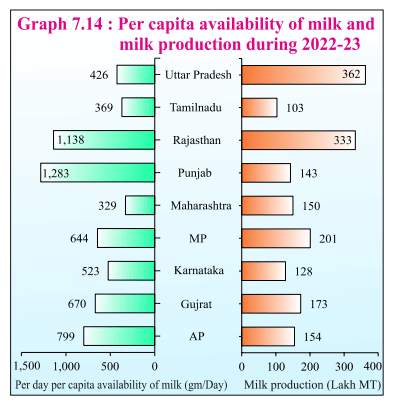
In terms of the Gross State Value Added (GSVA) which provides a snapshot of each sector's contribution to the GSDP of a state, primary sector (which includes agriculture) and the secondary sector (which includes industries) contributed a higher share to Gujarat's GSDP as compared to both sector's contributions to Maharashtra's GSDP.
It was only in the tertiary sector (which includes services, mainly IT) where Maharashtra had an upper hand over Gujarat.
Notably, at the time of formation of the two states in 1960, Maharashtra got to keep its biggest asset, Mumbai, while largely rural Gujarat with few industries around Ahmedabad and a low literacy rate (31.47 percent against 35.08 percent of Maharashtra as per 1961 census) was left to fend for itself.
Yet, despite not having any major rivers covering its length and breadth and lacking big technical educational institutes, if a state like Gujarat could beat all odds, notwithstanding its other shortcomings, and, more importantly, record a high PCI, it is for Maharashtra to decide whether it is Gujarat or the political class that came to rule over Maharashtra since its formation that has left a large chunk of its masses high and dry.
Surely, Maharashtra has not become poor just because a few companies decided to set up their factories in Gujarat in the recent past.
Key to solving any issue, or in case of Maharashtra — it's economy seemingly going on a backfoot and the purchasing power of it's residents dropping so much so that politicians are now proposing 50 percent reservation for Marathi-speakers in upcoming residential buildings in Mumbai — is to first introspect and acknowledge that there is a problem with our own world view.
It serves no good in denying that it is the state's highly self serving dynastic political class, largely derived from a single caste pool, in cahoots with a clumsy and corrupt bureaucracy, that is responsible for prospective businesses that could have come to Maharashtra and enhanced the income of its inhabitants, deciding to set shop in Gujarat or elsewhere in India.
However, if the Marathi Manoos chooses to take solace in the fact that Maharashtra contributes the lion's share in the Union government's tax revenue (again, thanks to the agglomeration of high revenue generating businesses around Mumbai and Pune alone, in a large state with 36 districts) and blames Gujarat for its pressing issues, there will be no end to its troubles.
Staff Writer at Swarajya





